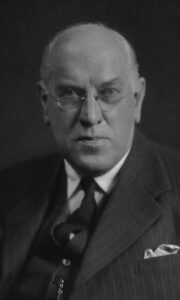H. Walford Davies
 Henry Walford Davies was born in the Shropshire town of Oswestry close to the border with Wales. He was the seventh of nine children of John Whitridge Davies and Susan, née Gregory, and the youngest of four surviving sons. It was a musical family: Davies senior, an accountant by profession was a keen amateur musician, who founded and conducted a choral society at Oswestry and was choirmaster of the local Congregational church. Two of his other sons, Charlie and Harold, later held the post of organist at the church; the latter was professor of music at the University of Adelaide from 1919 to 1947. In 1882 Walford was accepted as a chorister at St George’s Chapel, Windsor, by the organist, Sir George Elvey.
Henry Walford Davies was born in the Shropshire town of Oswestry close to the border with Wales. He was the seventh of nine children of John Whitridge Davies and Susan, née Gregory, and the youngest of four surviving sons. It was a musical family: Davies senior, an accountant by profession was a keen amateur musician, who founded and conducted a choral society at Oswestry and was choirmaster of the local Congregational church. Two of his other sons, Charlie and Harold, later held the post of organist at the church; the latter was professor of music at the University of Adelaide from 1919 to 1947. In 1882 Walford was accepted as a chorister at St George’s Chapel, Windsor, by the organist, Sir George Elvey.
When his voice broke in 1885 Davies left the choir and later that year was appointed organist of the royal chapel of All Saints, Windsor Great Park and was secretary to Elvey’s successor, Walter Parratt, and Dean (later Archbishop) Randall Davidson. At this time British universities, including Cambridge, awarded “non-collegiate” music degrees to any applicant who could pass the necessary examinations. Davies entered for the Cambridge bachelor of music examinations in 1889, but his exercise (a cantata, “The Future”, to words by Matthew Arnold) was not accepted. With the encouragement of Charles Villiers Stanford, professor of music at Cambridge, Davies made a second attempt; it was successful, and he graduated in 1891.
In 1890 Davies was awarded a scholarship in composition at the Royal College of Music (RCM), London, where he was a student until 1894. His teachers there were Hubert Parry and (for a single term) Stanford for composition, and W. S. Rockstro (counterpoint), Herbert Sharpe (piano) and Haydn Inwards (violin). While still at the RCM he was organist of St George’s Church, Campden Hill, for three months, and St Anne’s Church, Soho for a year until 1891, when he resigned for health reasons. In the following year was appointed organist of Christ Church, Hampstead; he remained there until 1897, holding the post in tandem for the last two years with an appointment from 1895 as teacher of counterpoint at the RCM in succession to Rockstro, a post that he held until 1903. He considered resigning the post in 1896, when he failed the counterpoint paper in the Cambridge examinations for the degree of Doctor of Music; he was successful at his second attempt, and the doctorate was conferred in March 1898.
In May 1898 Davies was appointed organist and director of the choir at the Temple Church in the City of London, a post he retained until 1923. With this appointment, in the view of his biographer, Jeremy Dibble, Davies began to be seen as a prominent figure in British musical life. As an organist he became well known both as a soloist and as a teacher – the most celebrated of his pupils being Leopold Stokowski. As a conductor he directed the London Church Choir Association (1901–13) and succeeded Stanford at the Bach Choir (1902–07).
As a composer Davies achieved his most substantial success in 1904, with his cantata “Everyman”, based on the 15th century morality play of the same name. His friend and biographer H. C. Colles wrote, “[T]he music itself was not like anything he had written before or would write again. “Everyman” was tumultuously received, and in the next few years given by every choral society in the country which aimed at a standard of firstrateness.” During the First World War Davies joined the Committee for Music in War Time under Parry’s chairmanship, organised concerts for the troops in France and musical events for the Fight for Right movement. In 1918 he was appointed director of music of the Royal Air Force, with the rank of major. He established the RAF School of Music and two RAF bands, and composed the “Royal Air Force March Past”, to which a slow “trio” section was later added by his successor, Major George Dyson. Since 1930 Walford Davies’ “Solemn Melody” has been one of the permanent selection of national airs and mourning music performed on Remembrance Sunday at The Cenotaph, Whitehall.
